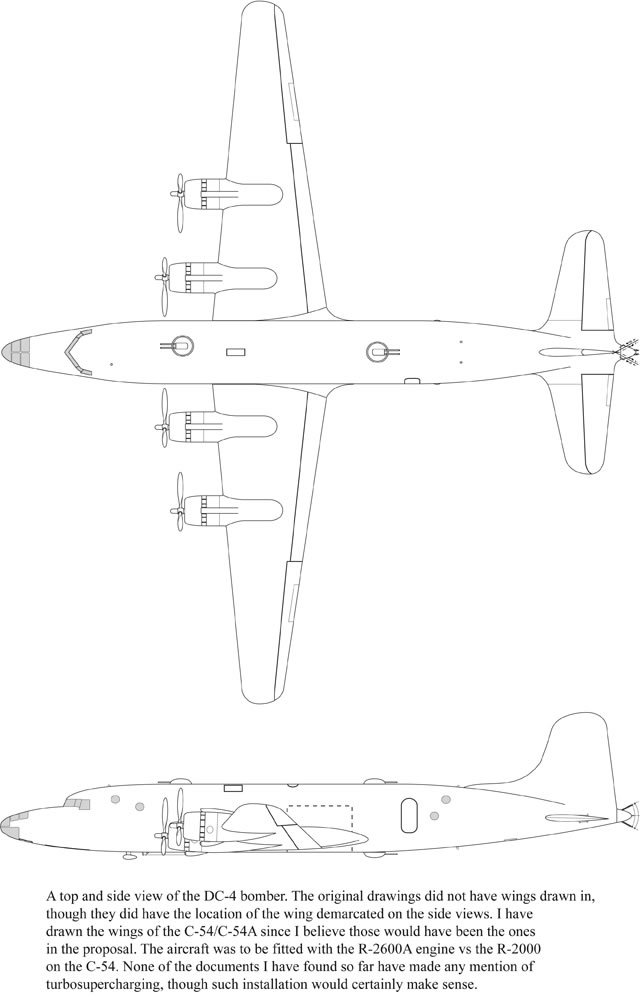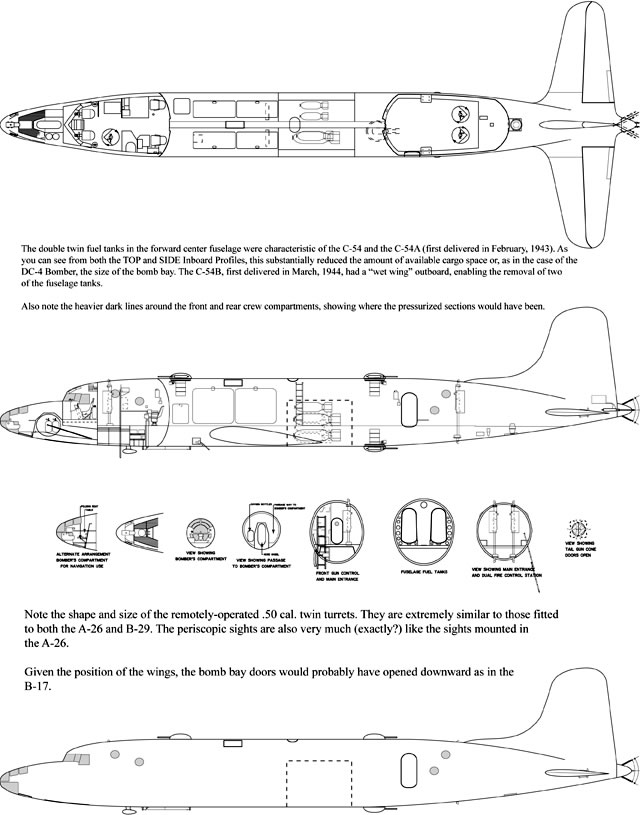|
DC-4 Bomber
by Alan Griffith

HyperScale is proudly supported by Squadron
As the 1930s dragged to a close, it became more and more obvious that war was on the horizon for the U.S. Still, Congress with its highly-isolationistic stance, coupled with the equally idiotic "America First" movement, consistently refused to fund needed U.S. military expansion. Fortunately, that didn't prevent the military from planning for war and the needed production. Tremendous expansion of aircraft manufacturing capacity due to French and British orders also played a key role.
A number of expansion programs were undertaken, in the end none of them adequate to the ultimate needs of a world-wide conflagration the size of WWII. One of those programs was the "1856" Bomber Program ("E") of early 1941. This program is described in more detail at the end of this article.
However, the purpose of this article is to share my information on the DC-4 Bomber, with a bit of history and drawings of the aircraft recreated in 1/72 scale.
The following article is broken into two parts: Part one is a description of the DC-4 Bomber within the "1856" Heavy Bomber Program along with drawings; Part Two is a descriptive letter about the "1856" Heavy Bomber Program itself. The overall focus is the DC-4 Bomber, however.
To my knowledge thus far, the DC-4 Bomber got no further than drawings, the ones I have found so far I have recreated here to 1/72 scale for those wanting to tackle a mod for the Revell C-54. These drawings are tracings and major cleanups of original Douglas drawings courtesy of the late, great Harry Gann, sent years ago to my friend George Cully who subsequently shared them with me. The drawings themselves were dated 5/?/41. It appears the day is either the 2nd or the 3rd.

Follow this link to download a 1/72 scale PDF of this illustration
(left click to open, right click to download).
The DC-4 bomber never received any other kind of designation that I have yet to find. This design was based on the DC-4/C-54, not the original DC-4 - often referred to as the DC-4E. A bomber version of the DC-4E had been earlier submitted by Douglas to a heavy bomber competition, but had been thoroughly rejected for many of the same reasons it was rejected as a commercial aircraft - too heavy, too slow, too complicated in its construction (and thus repair), too low a service ceiling, too short a range, not enough bomb load and major concerns about the type and location of defensive armament. This aircraft will be covered in depth in a future book.
The DC-4 Bomber was clearly looked upon with greater favor. While I have not yet been able to find performance figures of any sort, they must have been good enough to have been strongly considered for manufacture since it was specifically listed in the "1856" production figures dated April 23, 1941. One of the major differences between the DC-4 and the DC-4 Bomber was that the Bomber version was to have been powered by four R-2600A engines vs the R-2000 engines powering the C-54. An interesting tidbit about this was the plan to obtain engines by "substitution (to October 1942) of A-20 2-engine airplanes at 90 per month; for DC-4 Bomber 4-engine airplanes at 50 per month and by the combined production of R-2600A engines at Paterson." This seems to assume that we would not be at war before October, 1942.

Follow this link to download a 1/72 scale PDF of this illustration
(left click to open, right click to download)
A total of 500 DC-4 Bombers was stated as the number on order from Douglas/Santa Monica, with the total deliveries to occur in FY1942 and 1943, the Undelivered Balance to be 0 on July 1, 1943. Lockheed Vega was listed as a source for either the B-17E or the DC-4 for a total of 309 aircraft in the same time frame.
Cost of the completed 809 DC-4 Bombers (including spare engines, spare parts, Ordnance and radio equipment) was estimated to be $622,121,000 vs $521,406,000 for 1047 B-24s.
The DC-4 Bomber is one of those fascinating "What if?" projects. Proposed so closely to the beginning of WWII, the actual first flight of the C-54 would not occur until February 14, 1942. To this author, the logical conclusion is that once we were actually at war, all efforts had to go into aircraft already in production or previously contracted and in development (B-29 and B-32, for example). The need for long-range heavy cargo carriers would soon be made abundantly clear and the need for the C-54 far outweighed the need to develop the DC-4 Bomber.
The "1856" Bomber Program
If the reader wishes to explore USAAC pre-war expansion at a much greater depth, one of the better on-line sources is the digitized series on hyperwar.com of books by W.F. Craven and J. L. Cate, "The Army Air Forces in World War II". I especially draw your attention to Volume VI, Chapter 9 "Expansion of Aircraft Production". Although there are some giant gaps in coverage in the series on certain items in the series as a whole, the entire series is certainly worth a look.
http://www.ibiblio.org/hyperwar/AAF/VI/AAF-VI-9.html
Rather than going into an analysis of the program, I repeat here a letter to President Roosevelt describing it in a bit of detail:
"The President,
"The White House.
"Dear Mr. President:
"In accordance with your request, there are transmitted herewith proposed letters for your signature to the Secretary of War, the Secretary of the Navy, and the Director General of the Office of Production Management, pertaining to the additional heavy bombardment airplane program.
"To attain the desired goal of a production rate of 500 heavy bombardment airplanes per month, it will be necessary immediately to procure an additional 1856 airplanes of this type. The estimated total cost is approximately $1,500,000,000.
"This program is to be integrated with the procurement from appropriated funds and assumes early appropriation of the funds to carry out the 12,000 Airplane Program, covered by estimates now in the Bureau of the Budget. There will be a total of approximately 6,000 bombardment type airplanes, and it is of utmost importance that the facilities for this production, including those provided in the Lease-Lend Appropriation, be made available at the earliest possible moment.
"To insure the successful prosecution of this program, it is considered essential that the highest priority be given to all of its related phases; particularly to plant facilities, raw materials, machine tools, and other elements of production.
"A blanket preference rating of A-1-a would give a definite assurance of fulfillment of the program. It is believed, however, that the issuance of an A-1-b preference rating for the facilities and materials required for the production of the airplanes and components, coupled with an immediate expansion under an A-1-a preference rating of the facilities to manufacture machine tools and critical materials, will reasonably assure the completion of the schedule on time with little, if any, reduction in deliveries of articles in other defense projects.
"Of equal importance to the establishment of these preference ratings is the immediate authorization to proceed with all phases of the program. The resultant elimination of delay will do much to enlist the enthusiasm of the aircraft industry, an essential element in the success of this project."
"Respectfully yours,"
(unfortunately, the signature was
missing from the document)
There are a number of very interesting parts to the above. Perhaps the most telling - and reflected in the attachments, was a complete lack of comprehension of what would be needed to fight the oncoming war. Note the 12,000 Airplane Program with 6,000 heavy bombardment airplanes. This is as good a place as any to remind the reader that over 18,000 B-24s alone were produced during WWII.
The documents that followed this letter listed all the heavy bombardment types that were anticipated for construction. These consisted of: B-17, B-24, B-29, B-32 Douglas R40-B (I suspect this is the B-19A as the type of engine is correct for that aircraft), AND the DC-4 Bomber - to be produced at Douglas S.W. California and possibly also Douglas Tulsa instead of the B-24. Also mentioned in one of the pages is the B-33, but not specifically as a heavy bomber. My research to date suggests that the B-33 (Martin Model 190) was considered a 4-engine heavy medium bomber.
Copyright 2017 by Alan Griffith
Page Created 7 November, 2017
Last Updated
7 November, 2017
Back to Reference Library
|
Home |
What's New |
Features |
Gallery |
Reviews |
Reference |
Forum |
Search